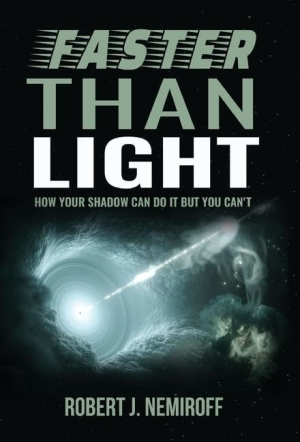Faster than Light
How Your Shadow Can Do It but You Can't
The thought-provoking science book Faster than Light unpacks the conceptual riddles surrounding the speed of light with winsome humor.
Robert J. Nemiroff’s enlightening popular science book Faster than Light probes the mind-bending implications of a universal constant.
Albert Einstein’s theory of the constant speed of light, Nemiroff says, can result in paradoxes, on both a quantum mechanics level and a cosmological scale. To address these, his book breaks down advanced scientific concepts in straightforward, direct terms, using specialized nomenclature in a sparing and accessible way. Across broad topical sections covering Earth, the universe, and relativity and communications, the chapters focus on subjects including superluminal history, improving light bulbs, and increasing the speed of laser spots. Each is detailed in covering both historical experiments and advanced ideas well, moving through dense concepts with systematic awareness and sharing digestible analogies to aid understanding, as when photon wave packets are compared to a locomotive-led train.
Aimed at the general public, the book focuses on ideas rather than particular math and data. Its scenarios are abstract but relatable. Multiple-choice quizzes are included at frequent intervals to help the audience check in with their developing understandings of the subjects—often including joking answers, like that it would be possible to take a train that moves away from the station faster than light in theory, but in practice the ticket would be too expensive.
Indeed, jokes are frequent in the text, humanizing the cerebral subject matter. Some are riffs, as with the juxtaposition of theories of quantum mechanics to theories of car mechanics. Others are more offbeat, as with a hypothetical question about whether someone could swing a long, straight pole around after a few beers and make it go faster than light; it quips, “It sure seems possible to create a sonic boom with a lit candle and a long piece of string, for the life of me I can’t figure out how.” These qualities help to make it both a classroom and a playground. Whimsical drawings further elucidate the concepts, illustrating the book’s suppositions well.
The book develops its observations far beyond the observable universe, coming to a fitting halt when it reaches a theory so esoteric that it led Einstein to stop in his tracks in the middle of the road to contemplate it. Encouraging further contemplation of the universe’s mysteries, the thought-provoking science book Faster than Light unpacks the conceptual riddles surrounding the speed of light with winsome humor.
Reviewed by
Joseph S. Pete
Disclosure: This article is not an endorsement, but a review. The publisher of this book provided free copies of the book and paid a small fee to have their book reviewed by a professional reviewer. Foreword Reviews and Clarion Reviews make no guarantee that the publisher will receive a positive review. Foreword Magazine, Inc. is disclosing this in accordance with the Federal Trade Commission’s 16 CFR, Part 255.

